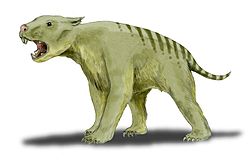| Priscakoala Temporal range: | |
|---|---|
| Scientific classification | |
| Domain: | Eukaryota |
| Kingdom: | Animalia |
| Phylum: | Chordata |
| Class: | Mammalia |
| Infraclass: | Marsupialia |
| Order: | Diprotodontia |
| Family: | Phascolarctidae |
| Genus: | † Priscakoala Black et al, 2012 |
| Species: | †P. lucyturnbullae |
| Binomial name | |
| †Priscakoala lucyturnbullae Black et al, 2012 | |
Priscakoala is an extinct genus of koala from the Early Miocene of Riversleigh, Australia. [1] [2] It has one species: Priscakoala lucyturnbullae. [2]
The prefix "prisca" comes from the Latin meaning old, ancient, primeval or primitive. [2] It was used to indicate that this genus is one of the oldest and simplest form of the koala. [2] The species P. lucyturnbullae was named for Lucy Turnbull a businesswoman, wife of former Prime Minister Malcolm Turnbull, and supporter of the research that discovered the genus. [2]

